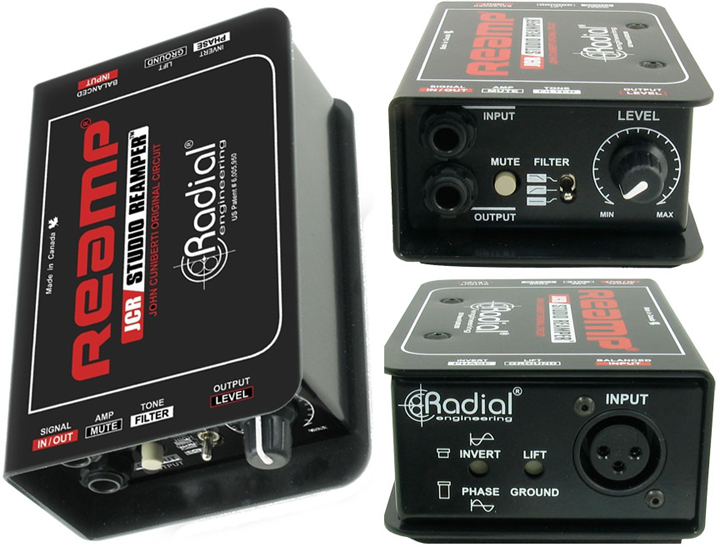

(And you probably already have one lying around so.) Get too fast and loose with the connections and now the simulator plugins are winning again.

But you will very likely have better results using a passive DI box backwards. You could likely get away with connecting a combo balanced/unbalanced 1/4" output directly to an amp input. You don't need to have both of your stereo monitors connected during the reamp pass. You can "borrow" one of the outputs you normally use for monitoring for the reamp work. So my question is which Audio interface would allow me to do it this way and what cables will i need for this process ? That is exactly what i need! There is no Di boxes were involved so simple! Now i am using Focusrite Solo audio interface and it does not have the output lines. The fact that Radial has packed so much versatile circuitry into a box not significantly larger than the J48, along with the Reamp JCR, is truly impressive.Hello guys! I saw a guy on Youtube showing how he takes his tracks out of DAW via the output on his Audio interface ( I could not see with audio interface he was using ) then send it to a guitar pedal Color Box processes it and then plug the output of the pedal back to the front input of his Audio interface. The quality of the Reamp Station’s DI was outstanding, and no surprise there, given my experience with Radial DI boxes. Over several reamping sessions, I sent signals from the Tascam and RME unit’s main outputs to the Reamp Station, as well as from each unit’s headphone outputs, to the Reamp HP.ĭestinations for reamping included a Fender ’68 Custom Princeton Reverb comboand a variety of effect pedals, among them an EarthQuaker Devices Special Cranker, a Gurus Echosex 3 Binson Echorec pedal and a Chase Bliss CXM 1978 Vintage Studioverb. DIMENSIONS: 5 7 /8” x 4 1 /8” x 1 3/4” (LxWxD)įor testing purposes, I tried both units to DI a variety of electric guitars and acoustic-electric guitars into my DAW via a Tascam Model 12 mixer as well as an RME Fireface 800 digital audio interface.īoth Radial reampers provide a path for connecting audio recordings to effects pedals.Without the reamp box there will be an impedance mismatch and loss of tone. The goal of the reamp box is to make the amplifier react in exactly the same way a live guitar would, but with a pre-recorded audio source. Reamp: 3.5mm audio input, Reamp in 1/4” TRS and XLR, amp out, link in, link out A reamp box converts a low impedance, balanced line level signal to high impedance, unbalanced instrument level signal. Reamp: Mute, filter (high-cut/low-cut/flat), level, ground lift I/O Direct Box: Instrument, thru, direct out. directly into the amp, particularly in the lower frequencies. Though it seems to do what it claims, there does seem to be a noticeable difference in the tone when routed this way vs. CONTROLS: Direct Box: Buffer, pad, 48V phantom power indicator, 180° polarity switch, ground lift. I purchased this item to reamp a guitar signal from a mixer into an amp (Guitar > Mixer > ART Dual RDB > Amp).These include 1/4-inch TRS and XLR input for connecting to the line-level outputs of your recorder, an amp output to feed the resulting instrument-level signal to your amp, and link in and out jacks to connect multiple Reamp devices for when you want to send one signal to more than one amp.Īlso here is a ground lift to eliminate hum and buzz from ground loops.Īll in all, the Reamp Station is a compact but feature-packed device that leaves no reamping problem unsolved. Speaking of the back panel, this is where you’ll find the remaining reamp features. The JCR’s front-panel features include a 3.5mm input that lets you reamp signals from mobile devices and handhelds a level control a three-position filter with settings for high-cut, low-cut and flat frequency response and a mute switch that cuts the signal to the 1/4-inch amp output on unit’s back panel. Once your guitar part has been recorded, the Reamp Station’s JCR comes into use with a custom-wound USA-made transformer that converts line-level signals to instrument level. The DI’s features continue on the back panel and include a balanced XLR output for connecting a recording interface or mixer, and a 180˚ switch that reverses polarity at the direct output to reduce phase cancellation when the DI is combined with mic’d amp.Ī custom-wound USA-made transformer converts line-level signals to instrument level


 0 kommentar(er)
0 kommentar(er)
